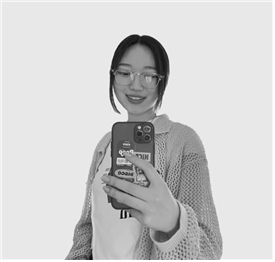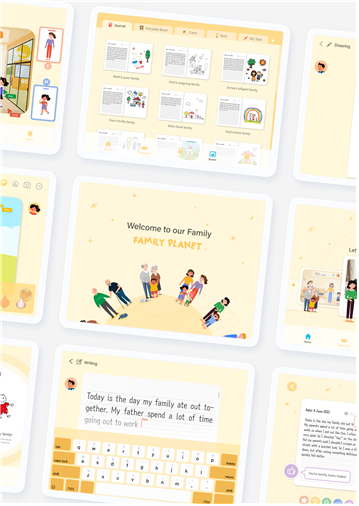Emotional Empathy to Lead the Understanding on Diversity Lee Seung-won, Lee So-eun, Kim Eun-ji of Department of Industrial Design
- Views 7397
- Writer 커뮤니케이션팀
- 보도일자 2023-02-10
Although there are various family types in our society, there are still discriminative perspectives to consider people who are different from others as abnormal by assigning specific modifiers. Some students stepped up to tackle such stereotype with their talents. Lee Seung-won, Lee So-eun, Kim Eun-ji (Department of Industrial Design) were honored to become the winners of iF Design Talent Award, one of the three most renowned design prizes in the world, with “Family Planet,” a project to provide quality education on how diverse families can exist. Sookmyung correspondents interviewed Lee Seung-won and Kim Eun-ji, who provided creative solutions for problems faced by the world, to listen to their story and impression of winning the award.
1. Hello? Before beginning the interview, please introduce yourselves.


Kim Eun-ji: Hi, I’m Kim Eun-ji majoring in industrial design. Lee Seung-won: I’m Lee Seung-won majoring in industrial design.
2. First of all, congratulations on winning an award at the iF Design Talent Award. Please share your thoughts.
Kim Eun-ji: I’m honored to win an international design contest. I did not imagine myself winning one when I was a freshman. I would like to share the honor with the members of my team.
Lee Seung-won: Right. Our team members did superb jobs and we received a lot of feedback from our professor. I think that were the reasons for us to win the prize of which we have never dreamed of. I think the support we had really helped us to win this unexpected award.
3. Could you briefly explain us about iF Design Talent Award?
Kim Eun-ji, Lee Seung-won: iF Design Award is an international design award started in Germany in 1953. Juries are comprised of experts from countries around the world to thoroughly review the designs based on fair criteria. Therefore, the red labels of iF awards assigned to award winners serve as symbols to gain trust from the design community, consumers, and the public. Winners can use the red label on their portfolio. It is a great honor as it provides a mark of winning an iF award.
Lee Seung-won: We applied for a global student competition called Talent Award. As it was for students, it was easy to access as all processes are carried out free of charge. Kim Eun-ji: Right. Some design contests including the Red Dot Design Award request submission fee of KRW 400,000 even to students. As iF award was free of charge, we were unburdened.
Lee Seung-won: We applied for a global student competition called Talent Award. As it was for students, it was easy to access as all processes are carried out free of charge. Kim Eun-ji: Right. Some design contests including the Red Dot Design Award request submission fee of KRW 400,000 even to students. As iF award was free of charge, we were unburdened.

4. What made you apply for the design award?
Kim Eun-ji: First of all, we were able to specify our project for iF award through UX Design II provided as an elective class for the Department of Industrial Design. We have set specific goals through the course, and it helped us a lot to participate in the award. Also, we thought that iF award was a great opportunity as there were not many design awards that were free to participate.
Lee Seung-won: As we continue to take classes, we often engage in projects that last about three months. We often face difficulties in organizing things related to such projects later. Since we started a project by setting the goal of submitting the outcome of the project to a design award, it was easier to organize the results. That was a huge advantage.
5. Do you think the award and your class had similar directions?
Lee Seung-won: The class was about choosing a certain issue and conducting research on it. The main theme of iF Talent Award was sustainable development goals of the UN. Kim Eun-ji: Among them, we selected quality education as our topic.
6. You won the award with your project, Family Planet. Could you tell us more about it?
Kim Eun-ji: We say a family is “normal” when it is comprised of parents and children in Korea. However, we often face more diverse family types abroad. Based on this, we decided our topic to help children learn various family types since young age so that they can better understand other family types with sound perspectives as they grow up.
Lee Seung-won: We examined the content related to multicultural families provided in the textbook of first year of elementary school during the research. I thought that the title of “multicultural family” seemed unilateral and limiting. We thought that it would be beneficial for all of us if we could understand each other, rather than giving names to certain types of families. If our app can be used to the school curriculum, it can provide solutions to bring an emotional empathy while writing a journal, creating a children’s book, and playing cards.
Kim Eun-ji: Right. I think Korean people like to give names like nuclear family, extended family. Our goal was to help children understand by themselves about family types, instead.

7. What was your priority when you were planning the design item?
Lee Seung-won: Our ultimate goal was to submit our project to the award. Thus, for us, sticking to the guidelines of the award was the most important. Under the goal of quality education, we narrowed in detailed topics. The bland topic of quality education provides too many options so we had to decide our approach and figure out specific issues that may occur and whether we can solve them. During the process, we discovered a detailed topic of family diversity. And we focused on it.
Kim Eun-ji: We kept thinking about how we could explain the topic persuasively. To that end, we paid a particular attention to examine many education curricula and interviewed children as we needed to listen to their opinions.
8. What was the biggest obstacle when participating in the award?
Kim Eun-ji, Lee Seung-won: It was difficult for us to do quantitative research. We faced difficulties in empathizing with children immediately regarding their thoughts about the issue as we are not eight. There were not many elementary school students we could talk to. So, we faced difficulties in figuring out what would they want to fix. We had to rely on desk research. And we couldn’t find that much user research.
9. Which experience you had in Sookmyung did help you during the process of preparing for the design award?
Kim Eun-ji: The fact that I am studying at Sookmyung Women’s University by itself helped me a lot. I met the teammates thanks to Sookmyung Women’s University. I would like to express my gratitude to my teammates once again. They laid the foundation for us to participate and win the award, helping me improve my shortcomings.
Lee Seung-won: The decision to apply for the award was an extension of class. We have learned everything from school; teamwork, mindset, design techniques. We can say that all our experiences actually came from Sookmyung Women’s University. There are many great professors. The professor helped us by giving sincere feedback. Our professor has a deep understanding about ordinary users as a design expert. The feedback was a great help. We bothered the professor a lot while we were preparing for the award.
10. What does Sookmyung mean to you?
Lee Seung-won: Independence. Outside of school, being able to do something doesn’t necessarily mean that I will get to do that something. I really liked the fact that I had to do and decide everything on my own since I entered this school. Sookmyung made me think and act independently.



